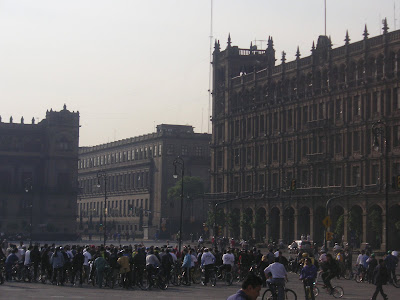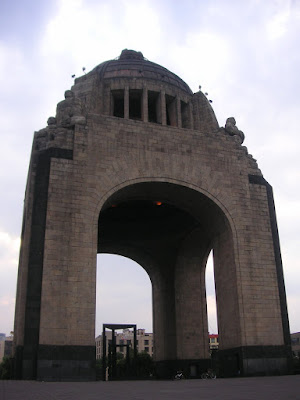
Puebla, both a state and a city 100km east of Mexico City where it is at the foot of the Popocatepetl volcano. Unlike many Mexican cities, this city was founded by the Spanish, and not built by the Aztecs and colonized by the Spanish. Therefore, Puebla is perhaps one of the most Spanish cities around Mexico. This includes a greater percentage of Mexicans with pure Spanish blood in them than other areas. The test of whether one is a Spanish descendant, is by observation of the exterior surface. Puebla, a truly unique Spanish colonial city in Mexico, has earned its rightful position as one of the
UNESCO World Heritage Site.

The shopping arcades of Puebla. There is no air-conditioning in these buildings or covered walkways.

The university of Puebla. Although it may be small, it still has some pretty magnificent architecture. Travelers visiting universities will realise that Singapore's universities may have a good reputation. But when it comes to architectural wise, it provides really great contrast.

The gardens in Puebla. A great place to escape the burning sun rays.

A grand church in Puebla.

Intricate designs of the interiors of the church. Every inch of this church is suitable to be printed on a postcard.

Every effort to build the church, sculpt the detailed patterns, paint the paintings, must have taken unimaginable and immense amount of effort and resources. It seems that this church is quite a contradiction with pragmatism. Or rather pragmatism does not mix well in this part of the world, or this part of the history.

One of the very few places with names relating to the Spanish colonialism. Apparently, the Mexicans after gaining their independence, wanted to shed off the traces of the colonial rule and any name with relation to colonialism is not allowed. One exception is this 'Hotel Colonial Restaurant' which has special permission due to its historical importance and exceptional colonial interior design.

The beautiful interiors of the restaurant.

Mexican fried rice.

Uniquely marinated with unique sauce.

Some wonderful alcoholic mixture to put a finishing touch to the otherwise average meal. What travelers should look for at this restaurant is their service and of course, the ambiance, at this historical building.

A girl at the souvenir shop who would hold on to some souvenirs to customers hoping that they would buy something.

This church in Cholula, around the Puebla region, is a unique one as it is built by the Spanish on top of an Aztec temple. The Spanish took some of the temple's stones and used it for the construction of their church.

The ceiling of the church.

Puebla area viewed from the Aztec temple and Spanish church. Puebla, a city full of history, architecture and culture.
Labels: Mexico
 After Mexico's independence, the Mexicans destroyed most of the Spanish colonial buildings. Only in the Mexico City's historical centre does some of the colonial buildings survived and now left standing in the 21st century. So precious is this area, Mexico's historical centre has been declared the UNESCO World Heritage Site.
After Mexico's independence, the Mexicans destroyed most of the Spanish colonial buildings. Only in the Mexico City's historical centre does some of the colonial buildings survived and now left standing in the 21st century. So precious is this area, Mexico's historical centre has been declared the UNESCO World Heritage Site. The Zocalo of Mexico City, or city centre of Mexico City, is a large and grand square, with one of the world's largest flag. This square is the site where thousands of people gathered together, and stripped, to do an artistic photo shot by a photographer. It took placed on 6th of May, the right time, but not exactly the right spot.
The Zocalo of Mexico City, or city centre of Mexico City, is a large and grand square, with one of the world's largest flag. This square is the site where thousands of people gathered together, and stripped, to do an artistic photo shot by a photographer. It took placed on 6th of May, the right time, but not exactly the right spot. The Zocalo is beaming with people, shoppers, tourists. Full of life; bustling with activities.
The Zocalo is beaming with people, shoppers, tourists. Full of life; bustling with activities. People are allowed to gather in Mexico.
People are allowed to gather in Mexico. Mexicans are probably quite nationalistic.
Mexicans are probably quite nationalistic.
 Paseo de la Reforma is the most important road in Mexico City. It is a wide street which is flunked by banks and hotels, and also decorated with statues.
Paseo de la Reforma is the most important road in Mexico City. It is a wide street which is flunked by banks and hotels, and also decorated with statues. With Mexico's strict laws, very few foreign banks can be found in this country. Banamex, Scotiabank of Canada and HSBC, are the three banks sighted.
With Mexico's strict laws, very few foreign banks can be found in this country. Banamex, Scotiabank of Canada and HSBC, are the three banks sighted.















































